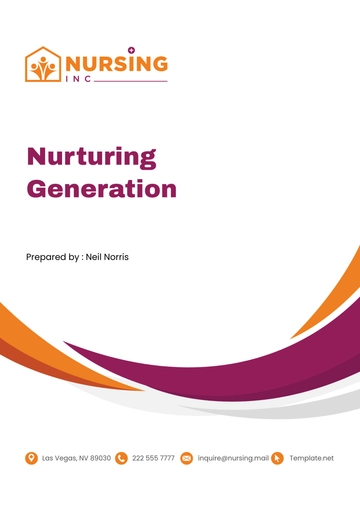Free Nursing Home Laundry Hygiene Protocol

I. Objectives
Aim and Purpose
The comprehensive objective of this document is to delineate and enforce a robust and effective laundry hygiene management protocol specifically tailored for nursing homes allied with [Your Company Name]. This protocol is dedicated to achieving the following:
Enhancement of Resident Well-being: Through the assurance of pristine, secure, and hygienically sanitized laundry conditions, contributing significantly to the improvement of life quality for residents.
Risk Mitigation: Proactively reducing health hazards associated with inadequate laundry hygiene, thereby safeguarding residents against potential infections and diseases.
Standardization of Procedures: Establishing a uniform and consistent approach across all present and forthcoming facilities under the [Your Company Name] umbrella, ensuring a standardized quality of service.
II. Protocol Overview
Scope and Coverage
This protocol encompasses a comprehensive spectrum of the laundry cycle:
Process Phases: Collection, Sorting, Washing, Drying, Ironing, Folding, and Redistribution of laundry items.
Key Focus Areas:
Effective Decontamination: Outlining essential steps and precautionary measures to ensure the laundry is free from harmful microorganisms without compromising fabric integrity.
Environmental Responsibility: Advocating for eco-friendly practices, including water and energy conservation techniques, and the utilization of sustainable resources and energy-efficient machinery.
III. Detailed Procedure
Step-by-Step Process
The hygiene standards in the laundry process involve meticulous steps, each crucial for maintaining the highest level of cleanliness and safety:
Collection:
Method: Nursing staff should collect used linens and garments, placing them directly into waterproof bags.
Safety Measures: Mandatory usage of disposable gloves during collection to prevent cross-contamination.
Sorting:
Criteria: Laundry items must be categorized based on color and fabric type to optimize the cleaning process and avoid damage.
Precautions: Sorting should be done while wearing disposable gloves to maintain hygiene integrity.
Washing:
Settings: Select the appropriate temperature setting and detergent based on fabric type, ensuring effective cleaning while preserving fabric quality.
Table of Fabric Care:
Fabric Type
Temperature Setting
Detergent Type
Cotton
Hot (60°C - 90°C)
Biological
Delicates
Cool (30°C)
Non-biological
Synthetics
Warm (40°C)
Biological
Drying:
Objective: Ensure thorough drying of laundry to eliminate any residual moisture, preventing the growth of mildew or germs.
Methodology: Utilize energy-efficient dryers or sunlight exposure where feasible, taking fabric type into consideration.
Folding and Distribution:
Procedure: Once completely dry, fold the laundry meticulously and organize it for easy identification and distribution.
Hygiene Maintenance: The distribution process should ensure minimal handling to maintain cleanliness until the items reach the residents.
Environmental Considerations
Water Conservation: Implementing batch washing strategies to minimize water usage without compromising on cleanliness standards.
Energy Efficiency: Preference for energy-saving laundry equipment that reduces electricity consumption and contributes to overall environmental sustainability.
This protocol aims not only to uphold the highest standards of laundry hygiene but also to embody [Your Company Name]'s commitment to the well-being of its residents and environmental stewardship. By following these procedures, we ensure a consistent, efficient, and responsible approach to laundry management across all our nursing home facilities.
IV. Data Collection and Analysis
Purpose and Importance
Data collection is a critical component of the laundry hygiene management protocol, serving as the backbone for continuous improvement and strategic decision-making. Collecting and analyzing data allows for a comprehensive understanding of operational efficiencies, resource utilization, and process effectiveness. The following outlines the approach to data collection:
Data Points:
Laundry Volumes: Track the quantity of laundry processed to identify peak times and adjust resources accordingly.
Resource Usage: Monitor the consumption of water, electricity, and detergents to pinpoint opportunities for cost reduction and environmental sustainability.
Time Metrics: Record the time taken for each phase of the laundry process to highlight inefficiencies and potential bottlenecks.
Frequency: Data should be collected and reviewed on a monthly basis, enabling trend analysis and timely interventions.
Transparency and Collaboration: All collected data should be communicated to [Your Company Name], ensuring transparency and fostering collaboration for protocol refinement.
Data Collection Methodology
Tools and Technology: Utilize digital tools such as software applications for real-time data tracking and analysis.
Staff Training: Ensure staff are trained in data collection techniques and understand the importance of accurate data recording.
V. Safety Considerations
PPE and Handling Protocols
Ensuring the safety of the staff involved in the laundry process is paramount. The following safety measures are instituted:
Personal Protective Equipment (PPE):
Mandatory use of gloves and aprons at all times during the laundry process.
Provision of face shields and masks for added protection, especially during the sorting of soiled laundry.
Laundry Handling:
Strict prohibition on touching soiled laundry with bare hands.
Implementation of color-coded bins to separate infectious or heavily soiled laundry, minimizing cross-contamination risks.
Chemical Safety:
Training on the proper handling of detergents and cleaning agents to prevent skin and eye exposure.
Availability of Material Safety Data Sheets (MSDS) for all chemicals used, outlining emergency procedures in case of accidental exposure.
VI. Expected Results and Benefits
Enhanced Hygiene and Health Outcomes
Adherence to this protocol is expected to bring forth significant improvements in hygiene and health conditions within the nursing homes. Key expected results include:
Reduction in Health-Related Incidents: A notable decrease in the occurrences of infections and diseases related to poor laundry hygiene, contributing to the overall well-being of residents.
Safer Living Environments: Establishment of a cleaner, safer, and more comfortable living environment for the residents, promoting a sense of well-being and satisfaction.
Consistency and Quality Assurance
Service Quality: Through the effective implementation of this protocol, [Your Company Name] aims to ensure a uniform and high-quality laundry service across all facilities, enhancing the reputation and trustworthiness of the brand.
Continuous Improvement: The protocol encourages ongoing evaluation and refinement of processes, driving innovation and efficiency in laundry management.
Quantitative Goals
Health Incident Reduction: Aim for a 30% reduction in health issues related to laundry hygiene within the first year of protocol implementation.
Efficiency Improvements: Target a 20% improvement in process efficiency through the optimization of resources and time management.
Sustainability Metrics: Achieve a 15% reduction in water and energy consumption, aligning with environmental sustainability goals.
By focusing on detailed data collection, stringent safety measures, and the realization of tangible health and environmental benefits, this protocol not only aims to improve the quality of life for residents but also sets a standard for operational excellence and sustainability in healthcare facility management.
VII. Conclusion
In wrapping up, this meticulously crafted document lays down a detailed and forward-thinking laundry hygiene management protocol tailored specifically for nursing homes allied with [Your Company Name]. By embracing and rigorously implementing this protocol, we stand on the cusp of not merely meeting but significantly exceeding the stringent hygiene benchmarks set forth in healthcare facility management. Our collective commitment to this cause is paramount, as it embodies our shared vision of fostering a living space that is not only clean and safe but also nurturing and health-promoting for all our residents.
The essence of this protocol transcends basic hygiene practices; it is a testament to our dedication to the well-being of those under our care and a reflection of our unwavering commitment to quality and excellence in service delivery. As we move forward, let us do so with a unified purpose and a steadfast resolve to transform our facilities into bastions of health and safety. Together, let us set a new standard for care in nursing homes, making [Your Company Name] synonymous with trust, care, and a deep-seated respect for the dignity of every individual we serve.
Prepared by: [YOUR NAME]
Company: [YOUR COMPANY NAME]
- 100% Customizable, free editor
- Access 1 Million+ Templates, photo’s & graphics
- Download or share as a template
- Click and replace photos, graphics, text, backgrounds
- Resize, crop, AI write & more
- Access advanced editor
Introducing Template.net's Nursing Home Laundry Hygiene Protocol Template! Carefully designed to maintain impeccable hygiene standards, it's an indispensable tool for nursing home administrators. With Template.net, enjoy editable and customizable features, enabling you to adapt the protocol to your facility's unique requirements. Utilize our AI editor tool to effortlessly modify and refine the protocol, ensuring a clean and safe environment for residents and staff alike.





























